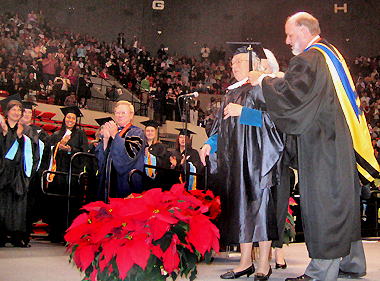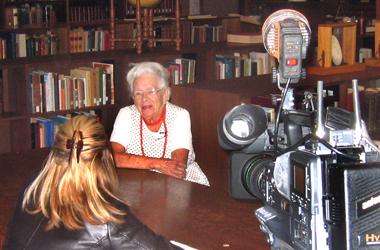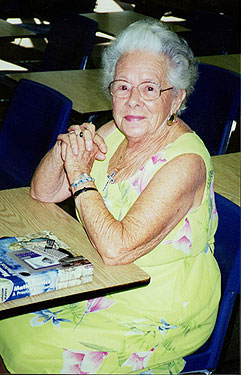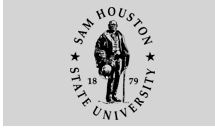Laura Thresher Johnston Earns Master's at Age 90
 |
Johnston receives her master's hood from Dean
Terry Thibodeaux.
--Photo by Frank Krystyniak
|
She's white haired, bright eyed, and only about five feet tall,
but the best way to describe 90-year-old Laura Thresher Johnston
is "inspirational."
On December 17 Johnston became the oldest Sam Houston State
student to receive a degree, accepting her master of arts in
history during ceremonies in Johnson Coliseum. Four years ago
she completed a bachelor's degree in Spanish.
Her accomplishments have made headlines throughout the United
States, the result of two stories by the Associated Press. Recently
she appeared in television news features in Houston and Bryan/College
Station.
Johnston's late and long educational journey at Sam Houston
State started when she was 73. She became interested in Spanish
when she first heard it being spoken in Florida, when she was
55.
"'That's so pretty,'" she remembers thinking. "'I
want to learn it.'" When her grandchildren began taking
Spanish it rekindled her interest, and she decided to do something
about it.
 |
Johnston is interviewed
by KPRC-TV (Channel 2) in Houston.
--Photo by Frank Krystyniak
|
She was living in Point Blank, east of Huntsville, and drove
the 30 miles over to Sam Houston State. She asked a receptionist
what she had to do to get into a Spanish class. The lady pointed
the way to a classroom where David Gerling was lecturing.
Johnston asked him if she could attend his class. "Sit
down," he told her in Spanish, she was smart enough to figure
that out, and did. Thirteen years later, at the age of 85, she
completed her bachelor's degree.
At first she thought she'd just sit in on a few Spanish classes,
which is allowed if space is available. Even that, she admitted,
was "a heck of a lot more difficult than I thought it was."
She took classes for no credit for two years, then decided, "If
I can pass these classes, I might as well try for a degree."
For awhile she paid full tuition and fees, but in 1995 the Texas
Legislature passed a law that exempted seniors (65 and over)
from tuition, providing space is available in classes they wish
to take.
 |
Johnston during her undergraduate
days.
--Photo by Frank Krystyniak
|
After she began taking courses for credit, she had to repeat
some to get a full grasp of the material.
She also volunteered in the foreign languages
office, occasionally helping Gerling with simple paper-grading.
In 1992, when a faculty member could not take a group on a scheduled
summer study program in Guadalajara, Mexico, she did.
"'She made us walk everywhere,'" she remembers the
students complaining.
She also traveled on her own one summer to Madrid, Spain, to
hear and speak Spanish as it is actually used, and where she
hung out in a cafe that Gerling said is frequented by some of
Europe's toughest truck drivers.
That was really no problem, since she has also traveled all
over the United States by herself in a camper, picking up hitchhikers
occasionally.
Johnston comes from a family that goes back to the early days
of the New England Pilgrim colony. Born Sept. 3, 1915, she
was a year old when her father died. She was put into an orphanage
briefly and then went to live with an aunt and uncle.
Johnston admits that some aspects of earning the master's in
history was easy for her, because she has lived so much of
it. Some of her early memories are of her uncle Dudley losing
his money in the stock market crash of 1929, of movie stars like
Janet Gaynor, Eddie Cantor and Douglas Fairbanks Jr., and the "terrible
depression."
She remembers hearing hunters firing guns in the woods near
where she lived, and thinking, "those Germans are getting
awful close." That timeframe was the first World War, not
the second.
Despite having no money, she said, they lived well. They had
15 acres, half covered with wild and planted fruit trees. Her
aunt made her clothes from burlap bags and she acquired their
cheerful perspective.
Once she wanted to go to a dance, but was embarrassed
by the holes in her shoes. Her uncle made her some cardboard
inserts, and told her not to worry.
"Of course you can go," he told her. "When they
look at your face they will never notice your feet."
She graduated from high school in 1933, earned a degree in nursing
in 1936 and worked in the field for 30 years. She married and
had three daughters--Jean, Jannelle, and Jeannette. She also
has eight grandchildren and 14 great-grandchildren.
At the age of 55, when some people move to Florida to retire
and rust, she moved there and started a new career.
She became a waitress. It took her awhile to learn things like
how to take an order and how many different ways steaks could
be cooked, but she became pretty good at it, and loved the Miami
Beach area.
"I made excellent money," she said, "and squandered
every bit of it."
Her daughter decided to move to Texas because of her husband's
job, and had to strongly encourage her mother to come along.
Her daughter, Jannelle Lofton, and granddaughter, Laura Gill,
both earned degrees from Sam Houston State.
She has fit in well with younger students.
"She was an adviser to the students--a mother figure to
many," said Gerling. "Laura was a living resource." One
student said that what Johnston was doing was "cool."
The educational trip to becoming a certifiable master was not
easy. She had to take a math class four times, including two
remedial classes. She did not expect any special treatment, and
doesn't believe she received any.
She took a history class that Caroline Castillo Crimm taught
one summer that involved the restoration of a cabin built about
1840. The students, in the East Texas heat and humidity, tore
it apart at its pasture location and put it back together on
a lot across the street from the Walker County Courthouse.
Johnston showed up at the ranch where the cabin was located
the day the de-construction was to begin. Crimm sent her home.
"I was a little concerned about her age," Crimm explained. "But
she was wonderful. She was willing to go out there and do whatever
needed to be done."
Crimm couldn't keep her away, though, so besides Johnston's contribution
to a chapter in a book about the project, she went down and chinked
logs in an area of the cabin that is known as "Laura's corner."
Johnston is aware that she is an inspiration, and encourages
others who might think it is too late in life to do something
they might have considered doing when younger to think again.
"I hope people will get out there and do things and not
just sit around," she
said. "If it's not continuing your education, it could be
volunteering." She does believe that reading is permissable
while you're resting, and said that if she doesn't pursue another
degree, possibly in political science, she plans to "read
every book in the (Gresham) library."
She has observed that many more folks, but not enough,
seem to be continuing their education at older ages.
"When I first came here, there was hardly anybody in their
mid-30s, 40s, 50s," she said. "Now you see them all
over campus."
The faculty members like Gerling and Crimm, the students who
made her feel welcome on campus, and the 6,000 people in Johnson
Coliseum, many of whom gave her a standing ovation when she received
her degree, are not the only ones who have noticed her accomplishment.
"Laura Johnston is a delight and inspiration to have on
the Sam Houston State University campus," said James F.
Gaertner, SHSU president.
"We taught her Spanish and history, but she taught us perhaps
more important lessons--that a love of life and learning is possible
for more years than we might have imagined. "
—END—
SHSU Media Contact: Frank Krystyniak
Dec. 23, 2005
Please send comments, corrections, news tips to Today@Sam.edu.
|


